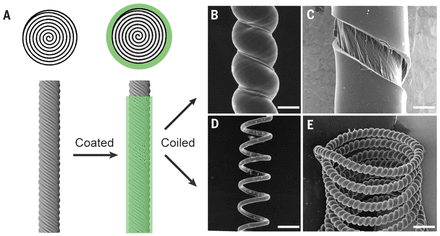 Jiuke Mu(1), Mônica Jung de Andrade(1), Shaoli Fang(1), Xuemin Wang(2,3), Enlai Gao(1,4),Na Li(1,5), Shi Hyeong Kim(1), Hongzhi Wang(6), Chengyi Hou(6), Qinghong Zhang(6),Meifang Zhu(6), Dong Qian(2), Hongbing Lu(2), Dharshika Kongahage(7), Sepehr Talebian(7),Javad Foroughi(7), Geoffrey Spinks(7), Hyun Kim(8), Taylor H. Ware(8), Hyeon Jun Sim(9),
Dong Yeop Lee(9), Yongwoo Jang(9), Seon Jeong Kim(9), Ray H. Baughman(1*)
Jiuke Mu(1), Mônica Jung de Andrade(1), Shaoli Fang(1), Xuemin Wang(2,3), Enlai Gao(1,4),Na Li(1,5), Shi Hyeong Kim(1), Hongzhi Wang(6), Chengyi Hou(6), Qinghong Zhang(6),Meifang Zhu(6), Dong Qian(2), Hongbing Lu(2), Dharshika Kongahage(7), Sepehr Talebian(7),Javad Foroughi(7), Geoffrey Spinks(7), Hyun Kim(8), Taylor H. Ware(8), Hyeon Jun Sim(9),
Dong Yeop Lee(9), Yongwoo Jang(9), Seon Jeong Kim(9), Ray H. Baughman(1*)
1)Alan G. MacDiarmid NanoTech Institute, The University of Texas at Dallas, Richardson, TX 75080, USA.//
2)Department of Mechanical Engineering, The University of Texas at Dallas, Richardson, TX 75080, USA.//
3)Department of Mechanical Engineering, Georgia Southern University, Statesboro, GA 30458, USA.//
4)Department of Engineering Mechanics, School of Civil Engineering, Wuhan University, Wuhan, Hubei 430072, China.//
5)Materials Science, MilliporeSigma, Milwaukee, WI 53209, USA.//
6)State Key Laboratory for Modification of Chemical Fibers and Polymer Materials, College of Material Science and Engineering, Donghua University, Shanghai 201620, China.//
7)Intelligent Polymer Research Institute, Australian Institute for Innovative Materials, University of Wollongong,Wollongong, New South Wales 2522, Australia.//
8)Department of Bioengineering, The University of Texas at Dallas, Richardson, TX 75080, USA.//
9)Center for Self-Powered Actuation, Department of Biomedical Engineering, Hanyang University, Seoul 04763, South Korea.
*Corresponding author.E-mail: ray.baughman@utdallas.edu.
원문 링크 : https://science.sciencemag.org/content/365/6449/150
Abstract
Although guest-filled carbon nanotube yarns provide record performance as torsional and tensile artificial muscles, they are expensive, and only part of the muscle effectively contributes to actuation. We describe a muscle type that provides higher performance, in which the guest that drives actuation is a sheath on a twisted or coiled core that can be an inexpensive yarn. This change from guest-filled to sheath-run artificial muscles increases the maximum work capacity by factors of 1.70 to 2.15 for tensile muscles driven electrothermally or by vapor absorption. A sheath-run electrochemical muscle generates 1.98 watts per gram of average contractile power—40 times that for human muscle and 9.0 times that of the highest power alternative electrochemical muscle. Theory predicts the observed performance advantages of sheath-run muscles.